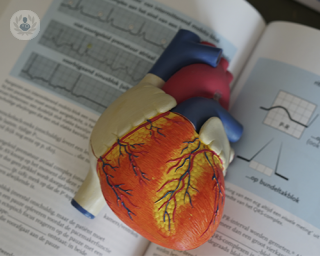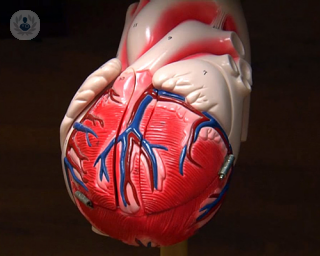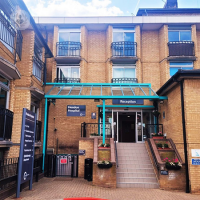Cardiac (catheter) ablation
What is cardiac ablation?
Cardiac, or catheter ablation is a treatment which is used to treat heart rhythm problems such as atrial fibrillation. Cardiac ablation uses either heat energy (radiogrequency) or cold (cryoablation) to target diseased areas of the heart to treat heart rhythm abnormalities and prevent these from arising and triggering arrhythmias.
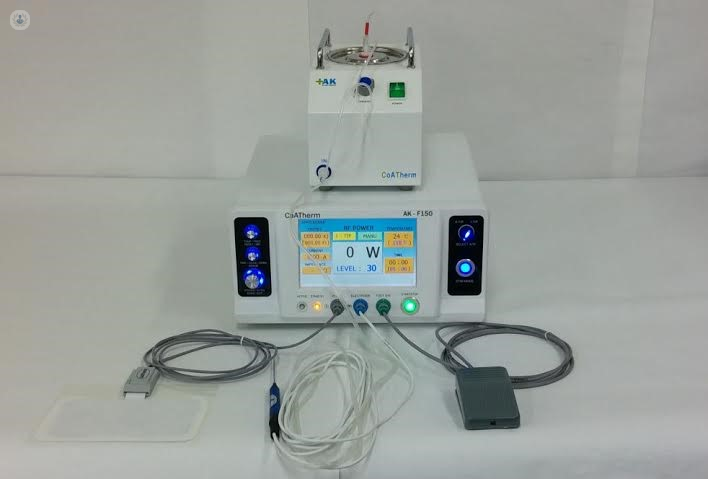
Why is cardiac ablation performed?
Cardiac ablation is performed in order to correct heart rhythm problems (arrhythmias). It can be used where drugs have been unsuccessful in treating arrhythmias. It can also be used in those who suffer serious side effects from arrhythmia medications.
However, cardiac ablation can also be offered as first line treatment before drugs in some cases. There are particular arrhythmias which respond well to cardiac ablation, including Wolff-Parkinson-White syndrome, AV nodal re-entry tachycardia, and paroxysmal atrial fibrillation.
What happens during cardiac ablation?
Cardiac ablation is a minimally-invasive procedure. A small incision is made in the groin, through which a catheter (small flexible probe) is inserted and guided through the femoral vein into the heart. These catheters are usually guided with an x-ray image, but there are specialist 3 dimensional (3D) mapping technologies that can navigate these catheters very precisely within the heart without needing to use x-ray.
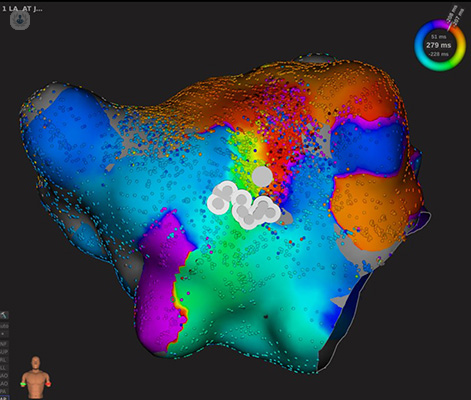
a pathwhich was successfully ablated (grey dots) in the central conducting region.
Once the catheter is placed, small electrodes connected to monitors are placed on different areas of the heart to detect which areas are causing the arrhythmia. Once the source of the problem is detected, radiofrequency (or cold) energy is applied causing a small scar in the area of abnormal tissue responsible for the electrical abnormality and the arrhythmia is treated.
The procedure can take between one to three hours, depending on the complexity of the arrhythmia and circuits within the heart. These procedures are done under both local anaesthesia and general anaesthesia, and your doctor will decide, after discussion with you, which might be the most suitable way to proceed with a catheter ablation procedure.
Preparing for cardiac ablation
Before the procedure, your doctor may perform tests to check you are suitable for the procedure. The night before the procedure is done, you will need to make sure to stop eating, but you can normally drink water or black tea or coffee (without milk) up until 6:00am on the morning of the procedure. Speak to your doctor about any medication you are taking to ensure that you follow the instructions about stopping, or continuing, with your medications in the lead up to the ablation procedure.
Before cardiac ablation is decided upon as a course of treatment, your cardiologist, specifically an electrophysiologist who is trained in treating heart rhythm disorders, will speak to you to evaluate which path is best, as ablation carries certain risks which must be taken into account. Risks include:
- damage to the heart’s electrical system, requiring a pacemaker
- stroke
- heart attack
- bleeding from the groin puncture
- pericardial effusion, from cardiac perforation
- emergency surgery
- some bloating and gastric fullness following surgery.
Overall however, cardiac ablation is considered to be a low-risk procedure. You should discuss the specific risks of your condition and treatment with your treating electrophysiologist.
Post-operative care
After the cardiac ablation, you will need to rest in the clinic or in the hospital for several hours, so bleeding is prevented at the site where the catheter was introduced, and your heart can be monitored.
Most ablation patients can be discharged on the same day and be given advice on groin management (it is normal to have a little ooze after the procedure), following a thorough assessment by the predischarge team.
Occasionally, following an atrial fibrillation ablation procedure, there can be periods of heart rhythm irregularities, which coincides with inflammation in the heart from the ablation for up to 4 weeks, before this typically subsides with the heart rhythm abnormality also subsiding. This is sometimes described as the "storm" before the calm in the context of an atrial fibrillation ablation procedure.
Regardless of the outcome, following the ablation, the best recovery strategy is to rest well including getting a good night sleep with little stress, and to increaase activity slowly on a day by day basis.

